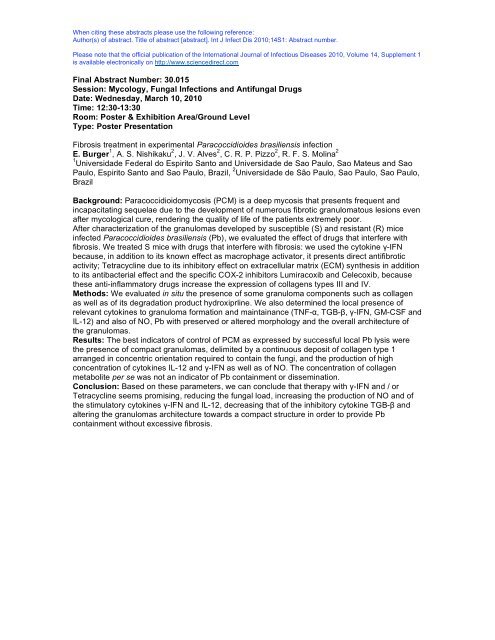14th ICID - Poster Abstracts - International Society for Infectious ...
14th ICID - Poster Abstracts - International Society for Infectious ...
14th ICID - Poster Abstracts - International Society for Infectious ...
Create successful ePaper yourself
Turn your PDF publications into a flip-book with our unique Google optimized e-Paper software.
When citing these abstracts please use the following reference:<br />
Author(s) of abstract. Title of abstract [abstract]. Int J Infect Dis 2010;14S1: Abstract number.<br />
Please note that the official publication of the <strong>International</strong> Journal of <strong>Infectious</strong> Diseases 2010, Volume 14, Supplement 1<br />
is available electronically on http://www.sciencedirect.com<br />
Final Abstract Number: 30.015<br />
Session: Mycology, Fungal Infections and Antifungal Drugs<br />
Date: Wednesday, March 10, 2010<br />
Time: 12:30-13:30<br />
Room: <strong>Poster</strong> & Exhibition Area/Ground Level<br />
Type: <strong>Poster</strong> Presentation<br />
Fibrosis treatment in experimental Paracoccidioides brasiliensis infection<br />
E. Burger 1 , A. S. Nishikaku 2 , J. V. Alves 2 , C. R. P. Pizzo 2 , R. F. S. Molina 2<br />
1 Universidade Federal do Espirito Santo and Universidade de Sao Paulo, Sao Mateus and Sao<br />
Paulo, Espirito Santo and Sao Paulo, Brazil, 2 Universidade de São Paulo, Sao Paulo, Sao Paulo,<br />
Brazil<br />
Background: Paracoccidioidomycosis (PCM) is a deep mycosis that presents frequent and<br />
incapacitating sequelae due to the development of numerous fibrotic granulomatous lesions even<br />
after mycological cure, rendering the quality of life of the patients extremely poor.<br />
After characterization of the granulomas developed by susceptible (S) and resistant (R) mice<br />
infected Paracoccidioides brasiliensis (Pb), we evaluated the effect of drugs that interfere with<br />
fibrosis. We treated S mice with drugs that interfere with fibrosis: we used the cytokine -IFN<br />
because, in addition to its known effect as macrophage activator, it presents direct antifibrotic<br />
activity; Tetracycline due to its inhibitory effect on extracellular matrix (ECM) synthesis in addition<br />
to its antibacterial effect and the specific COX-2 inhibitors Lumiracoxib and Celecoxib, because<br />
these anti-inflammatory drugs increase the expression of collagens types III and IV.<br />
Methods: We evaluated in situ the presence of some granuloma components such as collagen<br />
as well as of its degradation product hydroxiprline. We also determined the local presence of<br />
relevant cytokines to granuloma <strong>for</strong>mation and maintainance (TNF-, TGB-, -IFN, GM-CSF and<br />
IL-12) and also of NO, Pb with preserved or altered morphology and the overall architecture of<br />
the granulomas.<br />
Results: The best indicators of control of PCM as expressed by successful local Pb lysis were<br />
the presence of compact granulomas, delimited by a continuous deposit of collagen type 1<br />
arranged in concentric orientation required to contain the fungi, and the production of high<br />
concentration of cytokines IL-12 and -IFN as well as of NO. The concentration of collagen<br />
metabolite per se was not an indicator of Pb containment or dissemination.<br />
Conclusion: Based on these parameters, we can conclude that therapy with -IFN and / or<br />
Tetracycline seems promising, reducing the fungal load, increasing the production of NO and of<br />
the stimulatory cytokines -IFN and IL-12, decreasing that of the inhibitory cytokine TGB- and<br />
altering the granulomas architecture towards a compact structure in order to provide Pb<br />
containment without excessive fibrosis.
















